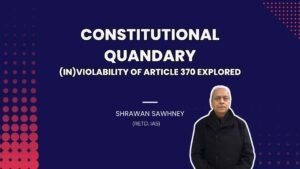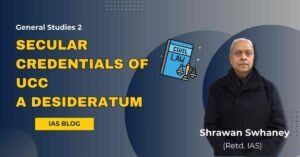Federalism and the Covid-19 Pandemic: A Constitutional Perspective
Federalism and the Covid-19 Pandemic: A Constitutional Perspective
Federalism - Quo Vadis
Recently, an article in a leading English national daily made a thesis that the outbreak of Covid-19 pandemic has led to our country being governed in a unitary manner, even though our constitution has laid down a federal structure of the government.
There was a cavil in the article that this unitary functioning required to be looked into and scrutinised by the Hon’ble Apex Court as being violative of our federal character.
It is relevant to point out the Central Government’s directives to all the States and Union Territories emanated under the Epidemic Diseases Act, 1897, a law which was first enacted to tackle bubonic plague in Mumbai (formerly Bombay) in former British India and Disaster Management Act, 2005.
These law are meant for controlling epidemics and national disasters by providing special powers that are required for the implementation of containment measures to prevent the spread of the disease or to manage the situation arising due to any disaster.
The Epidemic Diseases Act, 1897 has been routinely and continuously used to contain various diseases in India such as swine flu, cholera, malaria, and dengue in 2009, 2015 and in 2018.
Starting in March 2020, the Act has been enforced across India in order to prevent the spread of Covid-19 pandemic in India. Similarly, the Disaster Management Act, 2005, has also been used to control all kinds of disasters across the country.
A ‘doubting Thomas’ might question the propriety of invoking these Acts so as to curb freedom of States and UTs in tackling this pandemic and thereby diluting our federal structure. In order to ensure uniformity in the measures to be adopted by various States and UTs, as well as their implementation, the National Disaster Management Authority (NDMA), in the exercise of the powers under section 6(2)(i) of the Disaster Management Act, 2005, issued successive orders directing the Ministries / Departments of Government of India, and the State / Union Territory Governments and State / Union Territory Authorities to take uniform and effective
measures to prevent the spread of COVID-19 in the country.
In compliance with the orders of NDMA, Ministry of Home Affairs (MHA), GoI, also issued orders under Section 10 (2) (l) of the Disaster Management Act, 2005, also reiterated these directives proclaiming lockdown across the country which remained in force throughout the country for definite periods.
The central theme of this article is whether Centre’s enforcing uniform guidelines in the States / UTs in the wake of Covid-19 pandemic is, in any manner, tantamount to the infringing federal structure of our country.
The word ‘federal’ is derived from a Latin word ‘foeder’ meaning a compact or a league. Black’s Law Dictionary defines ‘federal’ as “a system of associated governments into national and regional components having different responsibilities.”
Likewise, a ‘federation’ denotes “a league or union of states….united under a strong central authority but retaining limited regional sovereignty.” (Emphasis added).
In the light of these connotations, an attempt is made to reconnoiter our federal structure. Normally, a federation comes into being with States parting with their sovereignty in favour of a central authority with a mandate that powers given to them shall not be taken away without their concurrence.
Unlike in the US and Australia, States in India did not have their own constitutions. They were governed by the Government of India Act, 1935, which was framed, broadly with a federal structure for the country.
Later, our Constitution was enacted with all the main ingredients of a federation to continue the legacy of the Government of India Act, 1935, keeping in mind the then needs and certain particularities of Indian polity.
Dr. Ambedkar said in his Constituent Assembly speech that “there is nothing to be ashamed of in borrowing. It involves no plagiarism. Nobody holds any patent in the fundamental ideas of a Constitution.”
In the wake of our diversity, plurality, and the historical perspectives and the fact, that there were more than 560 princely states having subsidiary alliance with the British Raj at the time of British withdrawal, the country needed a unifying basic law to bind the whole country into one.
The functioning of various federal systems manifested that there was a need to mitigate the rigidity and legalism of a federal constitution by adopting the modus vivendi of distribution of powers and certain other methods. Dr. Ambedkar said these provisions made the Indian Constitution “both unitary as well as federal according to the requirements of time and circumstances.” Framers of the Constitution incorporated salient features of a federation to make the Indian Constitution federal in form, albeit with certain unitary components, and enshrined special provisions to alleviate the rigidity of federalism.
Importantly, these provisions include, inter alia,
a) single Constitution for the Union and the States (special status of J&K has since been abolished in 2019);
b) Constitution attains unitary character during emergencies under Part XVIII of the Constitution (Articles 352-360);
c) single citizenship (state citizenship for J&K has been abrogated in 2019) for the whole of India;
d) a strong central authority with residuary powers over whole of the country and powers over the States under certain circumstances (Articles 246, 248, 249, 250 252);
e) Central Government can reorganize the boundaries of the States and change their names;
f) single integrated judicial system and appointment of Judges to the Supreme Court and High Courts and inter-state transferability of High Court Judges;
g) civil and criminal laws (though placed in Concurrent List) are codified by the Union Government and are uniformly applicable in the entire country;
h) uniform administrative system (all-India services) without impairing the federal canons;
i) single electoral machinery;
j) financial dependence of States on Union (Articles 268-281), etc.
A Constitution – the Bible of a nation – has to complement the individualities of the sovereign people who bring it into being. Hence, in the then temporal frame, our Constitution devised a new contrivance to meet the special requirements of Indian society.
It is, therefore, incontrovertible that Indian federalism is quite different from other federations in the world. Hon’ble Apex Court has also opined, in a catena of judgments, that ‘federal character of the Constitution’ is a basic element of the Constitution. Indubitably, ours is a ‘federal union’ sui generis.
By: Shrawan Sawhney (IAS Retd.)
The Views expressed by the author are personal.
Notes on "Federalism - Quo Vadis"
Introduction
The Covid-19 pandemic has led to an unprecedented governance challenge, raising concerns about the impact of central directives on India’s federal structure. While India is constitutionally a federal country, the pandemic necessitated centralized interventions under laws such as the Epidemic Diseases Act, 1897, and the Disaster Management Act, 2005, leading to a unitary style of governance. This note explores the constitutional and legal implications of such measures.
Legal Framework for Central Directives
1. Epidemic Diseases Act, 1897
Originally enacted to tackle the bubonic plague in British India.
Provides the central and state governments with special powers to curb the spread of epidemics.
Used in the past to control diseases like swine flu, cholera, malaria, and dengue.
Invoked nationwide in March 2020 to control the Covid-19 pandemic.
2. Disaster Management Act, 2005
Enacted to deal with disasters and emergency situations.
Establishes the National Disaster Management Authority (NDMA) with the power to direct states and UTs.
Under Section 6(2)(i), NDMA issued orders ensuring uniformity in Covid-19 containment measures.
Ministry of Home Affairs (MHA) enforced lockdowns using Section 10(2)(l).
Challenges to Federalism
Critics argue that the enforcement of uniform measures diluted India’s federal structure by:
Imposing centralized control over state-level responses.
Limiting the autonomy of states in managing the crisis.
Enforcing uniform lockdowns, which disregarded regional variations in Covid-19 spread.
However, the government justified this approach as necessary for:
Ensuring consistency in containment strategies.
Coordinating resources and policies effectively.
Preventing inter-state movement from exacerbating the pandemic.
Understanding Federalism in India
The term ‘federal’ originates from the Latin word foeder, meaning a compact or league. The Indian Constitution is often described as ‘federal with unitary features,’ meaning it allows for central dominance in specific circumstances.
Key Features of Indian Federalism:
Single Constitution: Unlike the U.S. and Australia, Indian states do not have separate constitutions.
Emergency Provisions (Articles 352-360): The Constitution becomes unitary in times of emergency.
Single Citizenship: Citizens owe allegiance to the Union rather than individual states.
Residuary Powers (Articles 246, 248, 249, 250, 252): The Union has overriding legislative powers.
Reorganization of States: The Centre has the power to alter state boundaries.
Unified Judicial System: The Supreme Court and High Courts form an integrated judiciary.
Uniform Civil and Criminal Laws: Placed in the Concurrent List but largely codified by the Centre.
All-India Services: Centralized recruitment for administrative roles.
Financial Dependence: States rely on Union grants and revenue-sharing (Articles 268-281).
Indian Federalism: Unique Yet Adaptable
Dr. B.R. Ambedkar stated that the Indian Constitution is both “unitary as well as federal according to the requirements of time and circumstances.” Unlike classic federations, India’s structure accommodates strong central control when necessary, making it a sui generis federal model.
The Supreme Court has repeatedly upheld the ‘federal character’ of the Constitution as a basic feature. However, it has also recognized the necessity of unitary measures in exceptional situations such as pandemics.
Conclusion
The Covid-19 pandemic tested the resilience of India’s federalism. While the Centre’s directives under the Epidemic Diseases Act and Disaster Management Act led to a unitary governance approach, these measures were legally justified given the national emergency. The Indian model of ‘quasi-federalism’ ensures flexibility in governance while maintaining the federal spirit. Future legal scrutiny may further refine the balance between central authority and state autonomy in crisis situations.
Questions based on "Federalism - Quo Vadis"
1. Discuss the impact of the Covid-19 pandemic on India’s federal structure. (250 words)
Answer Framework:
Introduction: Define federalism and India’s quasi-federal nature.
Main Body:
Legal basis: Epidemic Diseases Act, 1897, and Disaster Management Act, 2005.
Centralized response during Covid-19 (lockdowns, NDMA directives).
Challenges to federalism (state autonomy vs. national uniformity).
Justifications for central intervention.
Conclusion: Discuss the future of Indian federalism and the need for balance.
2. Examine the constitutional provisions that allow India to function as a unitary state during emergencies. (250 words)
Answer Framework:
Introduction: Define emergency provisions in the Indian Constitution.
Main Body:
Articles 352-360: National Emergency, State Emergency, Financial Emergency.
Impact on federalism (centralization of power, suspension of state autonomy).
Covid-19 response under Disaster Management Act, 2005.
Judicial interpretation on federalism during emergencies.
Conclusion: Need for checks and balances in emergency governance.
3. Compare Indian federalism with the federal models of the USA and Australia. (250 words)
Answer Framework:
Introduction: Define federalism and types of federations.
Main Body:
U.S. model: Dual federalism, separate state constitutions, state sovereignty.
Australian model: Cooperative federalism, shared governance.
Indian model: Quasi-federalism, unitary bias, single Constitution.
Flexibility in the Indian model (e.g., Covid-19 governance).
Conclusion: India’s unique federal structure and adaptability.
4. Analyze the role of judiciary in maintaining the federal balance in India. (250 words)
Answer Framework:
Introduction: Role of judiciary in interpreting federalism.
Main Body:
Key judgments upholding federalism (e.g., S.R. Bommai case).
Judicial interventions during emergencies and pandemics.
Balancing central and state powers through judicial review.
Conclusion: Judiciary as the guardian of the Constitution and federal principles.
Prelims Questions based on "Federalism - Quo Vadis"
-
Constitutional Quandary: Inviolability of Article 370 Explored
Upon adoption of the Constitution of India, the preamble proclaimed,... -
Decoding Article 370 – A Historical Retrospect
The Apex Court is currently hearing petitions disputing the amendment... -
Sedition In India-Modern Era
English inhabitants in India requested the then Indian rulers to... -
Sedition In India – A Historical Retrospect
Sedition is perhaps the very vaguest of all offences known... -
Contours of Free Speech
Recent a spate of cases against stand-up comics Munawar Faruqui,... -
Generation-Z And Clout Culture
Generation Z, also known as Gen Z-ers and Zoomers, is... -
Community Resources :An Equitable Landscape
Community Resources: An Equitable Landscape Table of Contents Blog - Community... -
Federalism and the Covid-19 Pandemic: A Constitutional Perspective
Recently, an article in a leading English national daily made... -
Uniform Civil Code – A Historical Perspective
Article 35 of the draft Constitution of India provided that... -
Secular Credentials Of UCC – Shrawan Sawhney
Recently, the 22nd Law Commission of India has set the...











